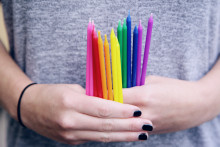The workshop began with revisiting the workflow of designers. According to Denz, designers define a target group for the product they develop. Target groups get designated by criteria such as age ranges, socioeconomic strata, or gender. A designer may ask ‘will this product be used by a woman or a man?’ Based on the answer, designers make assumptions about which abilities or needs will that particular target group have. Such assumptions translate into the product’s features. How heavy should it be? Which colours are more suitable?
‘Designed products are given gender scripts,’ explained Denz. Objects have the power to suggest how they should be used and can prompt consumers to associate them with specific gender roles. That is when the Queer Theory becomes relevant to product design.
What is Queer?
Drawing from Judith Butler’s philosophy, Denz explained that rather than assuming ‘male’ and ‘female’ are natural categories, gender can be seen as becoming socially constructed over time. Through repetitive practices that stem from social expectations of how a woman or a man should behave, ‘gender is real only to the extent that it’s performed,’ explained Denz.
Queer comes as a response to these strict gender demarcations. Even though it’s an often contested term in gender studies, Denz clarified that its most simple definition is ‘that which violates or goes against gender norms’. Additionally, ‘Queer’ is used to express a changing rather than a static ‘female’ or ‘male’ identification. ‘Queer is an identity that is always under construction, in permanent becoming,’ said the design student.
Identifying gender scripts in objects
Designers can become aware of how their products are embodying traditional gender norms. To illustrate this, workshop participants were taught how to identify gender scripts on products. Each attendant was asked to put an object they were carrying with them over the table. Watches, a cologne, a pink lip balm, and heart-shaped sunglasses were among the products on sight. Divided into teams, participants analysed which features of the object could be identified as ‘gender scripts’. They pointed out the colours or shapes of the object, the marketing strategies behind them, or their intended use.
‘Remember symbols always act in context,’ said Denz, suggesting that users can consciously subvert the objects’ scripts and challenge gender roles while still using them. However, the workshop continued by asking participants to give ideas of how gender norms could be deconstructed in the process of design.
Denz believes that product designers have the responsibility to halt heteronormative roles and stereotypes, and he hopes that consumers can gain more freedom in how they perform their identities beyond the male-female gender binary.







